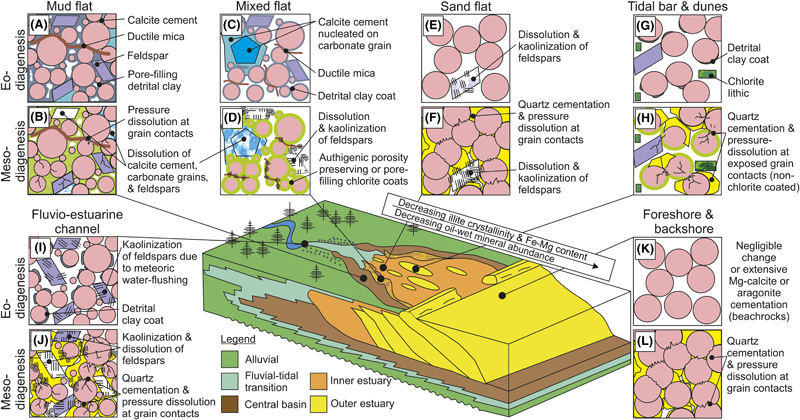The AAPG/Datapages Combined Publications Database
AAPG Bulletin
Figure
AAPG Bulletin; Year: 2019; Issue: April DOI: 10.1306/09181818025
Return to Full Text

Figure 16. Summary schematic to facilitate reservoir quality prediction based upon compositional variation in the wave- and tide-dominated Ravenglass Estuary, United Kingdom and likely eo- and mesodiagenetic pathways, after Worden and Morad (2003) and Morad et al. (2010). Oil-wet mineral abundance is the sum total of calcite, dolomite, kaolinite (assuming early alteration to kaolinite booklets), hematite, feldspar (assuming weathered; unweathered feldspars are water wet), and Fe-rich chlorite abundance, after Barclay and Worden (2000). Detrital clay coat coverage (precursor to authigenic clay coats during mesodiagenesis) is based on previous studies in the Ravenglass Estuary (Wooldridge et al., 2017a, b, 2018). For each depositional environment, a schematic petrographic image (A–L) under eodiagenetic (<2000 m [<6562 ft]; <60°C–70°C) and mesodiagenetic (>2000 m [>6562 ft]; >60°C70°C) conditions (above and below, respectively), is shown. The subsurface part of the block diagram is modified from Dalrymple et al. (1992).

Figure 16. Summary schematic to facilitate reservoir quality prediction based upon compositional variation in the wave- and tide-dominated Ravenglass Estuary, United Kingdom and likely eo- and mesodiagenetic pathways, after Worden and Morad (2003) and Morad et al. (2010). Oil-wet mineral abundance is the sum total of calcite, dolomite, kaolinite (assuming early alteration to kaolinite booklets), hematite, feldspar (assuming weathered; unweathered feldspars are water wet), and Fe-rich chlorite abundance, after Barclay and Worden (2000). Detrital clay coat coverage (precursor to authigenic clay coats during mesodiagenesis) is based on previous studies in the Ravenglass Estuary (Wooldridge et al., 2017a, b, 2018). For each depositional environment, a schematic petrographic image (A–L) under eodiagenetic (<2000 m [<6562 ft]; <60°C–70°C) and mesodiagenetic (>2000 m [>6562 ft]; >60°C70°C) conditions (above and below, respectively), is shown. The subsurface part of the block diagram is modified from Dalrymple et al. (1992).